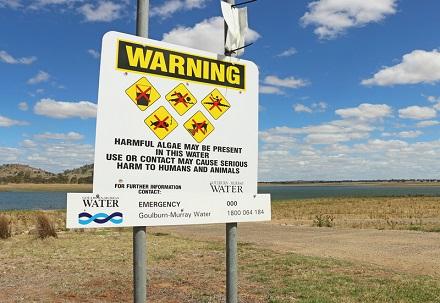

Although public health officials said they tested the water before and after the race and did not find any toxins from blue-green algae, the City of Madison still closed four local beaches less than 10 days later (including two on Lake Monona) for high levels of blue-green algae.
Madison isn’t alone, as blue-green algae — a type of bacteria technically known as Cyanobacteria that thrives in warm, nutrient-rich waters and can form harmful blooms that look like pea soup or spilled green paint — are invading lakes all over the country.
Officials with the July 7 Massachusetts State Triathlon were prepared to cancel the swimming portion, pending the results of water sample tests from Lake Dennison in the Town of Winchendon. The lake had been closed to recreational activities since June 23, when tests for blue-green algae came back high. But subsequent testing days before the competition revealed that acceptable levels had returned.
Humans can react adversely if they swallow, have skin contact with or breathe in airborne water droplets that contain harmful blue-green algae; symptoms typically begin within hours of exposure and can include vomiting, diarrhea, a rash, eye irritation, coughing, a sore throat and headaches.
Triggered by a warmer-than-usual spring in many parts of the country, blue-green algae also has been blamed for the deaths of several dogs this summer. Exposure can occur while swimming or by licking cyanobacteria or toxins off their fur or hair, according to the Centers for Disease Control, which says animals are often the first to be affected by blue-green algae, because they are more likely than humans to swim in or drink contaminated water.
In late August, New York City residents were warned to stay away from lakes in Central Park and Brooklyn after high levels of blue-green algae were detected.
“There are a bunch of fish and turtles that die on a regular basis, so you don’t know what’s in there,” one dogwalker told the New York Post about Central Park’s Harlem Meer. “You see a lot of floating turtles. It’s pretty awful.”
Blue-green algae is not a new challenge for event owners, nor is it the only water-based anxieties they’re facing— including cryptosporidium and flesh-eating bacteria — this summer.
In 2017, Sports Destination Management reported that event planners may want to consult with an event insurance company regarding planning for additional coverage that may be necessary when hosting water-based events.
“If a claim were to be brought against an organization that had purchased this coverage, they would be insured,” Lorena Hatfield, marketing manager for K&K Insurance, told SDM at the time, adding that her firm offers transmissible pathogens coverage. “It’s important to know that this is not standard coverage offered in the general marketplace.
The Centers for Disease Control warns to “[a]void drinking, playing, swimming, water skiing, boating, or practicing other activities in areas where the water is discolored and has a bad odor, or where there are visible foam, scum or mats of algae on the water’s surface.”
From an environmental perspective, precautions can be taken, too. As the Minnesota Pollution Control Agency notes on its website: “We can’t eliminate blue-green algae from a lake — they are an inherent part of the overall algal community. What we really want to do is control their overall intensity and the frequency of the blooms. Since we can’t control the water temperature, the best thing we can do is to reduce the amount of nutrients getting into the lake. This can best be accomplished by reducing the amount of phosphorus and nitrogen from man-made sources such as lawn fertilizer, and runoff from cities, cultivated fields, feedlots and a myriad of other sources. Though a reduction of nuisance algal blooms will not be immediate, it is the best long-term solution to minimizing the frequency and intensity of algal blooms.”

